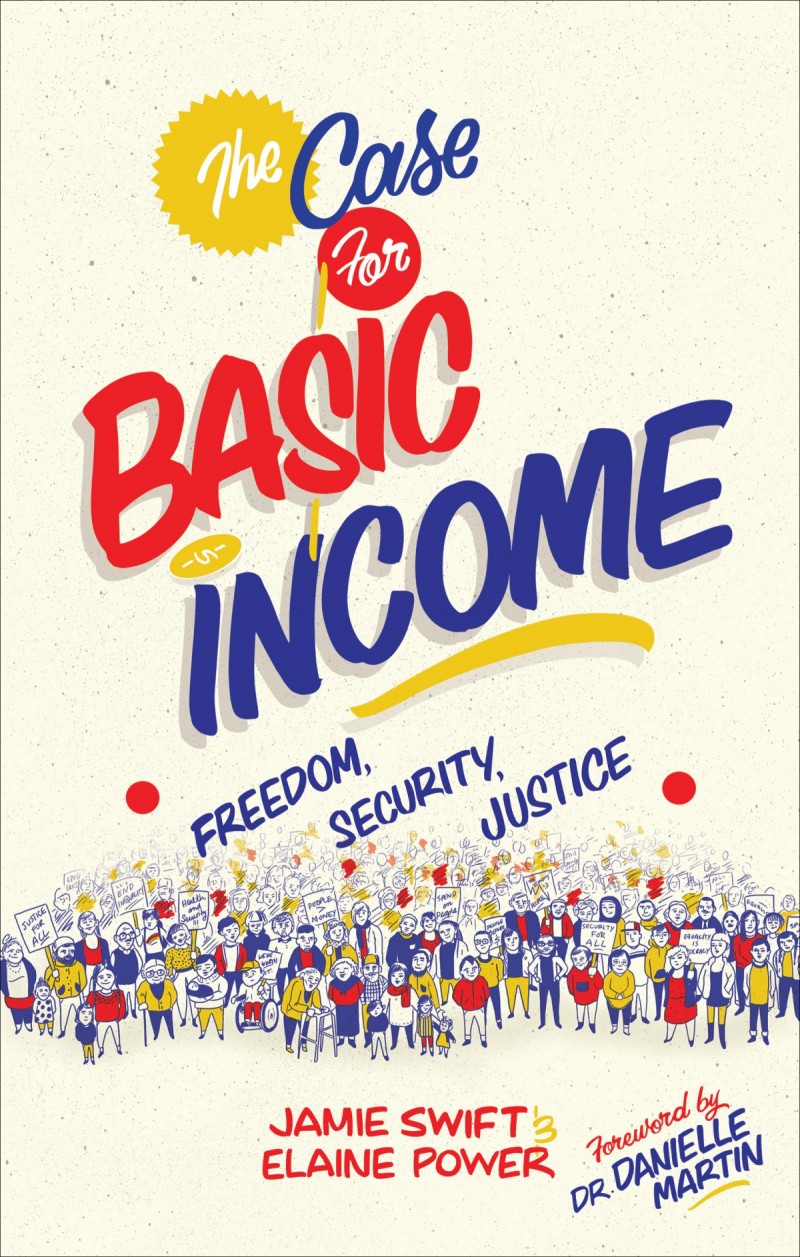How COVID-19 and CERB proved that basic income is not only possible—it works

The Canada Emergency Response Benefit has been an essential lifeline for millions of Canadians during the pandemic, amounting to just the sort of no-strings-attached Basic Income that had already been gaining worldwide attention in recent years. Photo by Ashwini Chaudhary/Unsplash.
The following is excerpted from The Case for Basic Income by Jamie Swift and Elaine Power. Copyright © 2021 Jamie Swift and Elaine Power. Published by Between the Lines. Reproduced by arrangement with the publisher. All rights reserved.
Late in the winter of 2020, it was dawning on Canadians that the COVID-19 crisis was starting to shake things up in unimagined ways. A Kingston man wheeled a supermarket cart groaning under the weight of water, five cases of twenty-four plastic bottles. As he loaded it into his late-model SUV, he was asked why he was buying so much—“Lots of water in the tap?” His reply didn’t catch the irony. It was sincere, clearly anxious: “I hope so.”
Gnawing insecurity abounded everywhere, daily certainties suddenly evaporating. Would there be enough food? How about public transit? Passing encounters with strangers in stores? What if they took the bus to get there? Jobs evaporated. Pop-up roadside signs blinked the insistent message “Stay Safe, Stay Home,” municipal authorities carelessly assuming it was possible for everyone to do so. The stress pandemic quickly spread, the anxiety in part provoked by the sense that, suddenly, things seemed out of control.
For millions of Canadians who depend on precarious jobs or, even worse, social assistance, the stress of lives being out of control is hardly new. It’s the commonplace stuff of daily life. Forget about hoarding food, or anything else for that matter. Providing food generates anxiety every single day. With the unexpected arrival of COVID generating mass anxiety, Canadians experienced what could be described as the normalization of insecurity. Unemployment skyrocketed as businesses from retailers to airlines laid off workers en masse.

Many could hope that the insecurity would, in the fullness of time, pass as things returned to normal. In the interim, the threat of Depression-level joblessness—coupled with a collapse of consumer spending—quickly gave rise to what Milton Friedman called, in a different context, “helicopter money,” the image being that of a government helicopter hovering around tossing thousand-dollar bills onto people. The famous right-wing economist had a gift for metaphor.
In Canada, helicopter money took the form of public assistance to the unemployed as well as some underemployed gig and part-time precarious workers through the Canada Emergency Response Benefit (CERB), introduced in mid-March. By mid-April, 6.7 million Canadians had applied for either EI or CERB benefits; by early May, that figure had climbed to almost eight million.
The launch of CERB demonstrated that previously inconceivable amounts of money could be mustered for social programs when the political will is strong. The obvious need for CERB exposed the utter inadequacy of the Employment Insurance (EI) system—and indeed the country’s entire income security system. The speed of the emergency aid demonstrated that it is possible to do something that would have been unthinkable when market fundamentalism had reigned supreme, colonizing the imagination of the country’s political class. The CERB lasted for months, supporting people in need, amounting to just the sort of no-strings-attached Basic Income that had already been gaining worldwide attention in the period before the pandemic.
The CERB amounted to a huge precedent, yet it did not reach everyone. It still left out those who had little or no “labour market attachment.” Thus, 16 percent of jobless Canadians, about 1.4 million people, did not qualify either for the CERB or for EI. There are three main reasons why so many were excluded. They either: were out of work before March 15 but did not qualify for EI, did not meet the threshold of having made $5,000 in the past twelve months, or had quit their jobs recently.
By focusing on people who had paid employment, the CERB maintained the stark division between the so-called deserving and undeserving, long a bedrock of income security programs. The “deserving” receive benefits from Employment Insurance, the Canada Pension Plan, Old Age Security, and the Guaranteed Income Supplement. The “undeserving” get miserly benefits in the form of social assistance, and as a consequence are stigmatized and subjected to suspicion and surveillance in the form of hundreds of rules. It’s what many low-income people refer to as “the system.”
No amount of established evidence about the costs of keeping social assistance recipients trapped in poverty—or the unfairness of a broken, punitive system—seems to change the dominant view. Twenty-first-century income security remains mired in nineteenth-century thinking—bourgeois moral values championing employment and, for those unable to work for pay, the workhouse. Or welfare.
There were other problems with CERB. It contained a strong disincentive for part-time employment: once a worker made more than $1,000 per month, CERB benefits were cut off. And laid-off workers could not refuse work and continue to collect CERB, even if they feared for their own or their loved ones’ health and well-being. Nevertheless, Basic Income proponents immediately noted that CERB was proof that Canada could bring in a no-strings-attached income floor. As they had been arguing for years, Canada already has a precedent for no-obligation, guaranteed benefits—except that people qualify for the universal Old Age Security and the means-tested Guaranteed Income Supplement only when they reach their later years.
The CERB showed that unconditional state aid is both possible and necessary. It was an opening for the activists who had built Canada’s Basic Income campaign. The timing was auspicious. Weeks before the pandemic, the Basic Income Canada Network (BICN) published the first-ever detailed set of policy options for a Canadian Basic Income, defined as an unconditional cash transfer from the state to individual people. The money would be unrelated to work status. It would enable everyone to meet their basic needs while participating more fully in social life—in essence, to live with a measure of dignity.
“It is clear from child and seniors benefits that it works for many Canadians already,” said BICN co-founder Sheila Regehr, who had also experienced poverty as a young parent. “The federal government’s priority now must be to take leadership to make it work for everybody; we are all part of the future of this country.”
Regehr and Ottawa policy analyst Chandra Pasma, together with a small team of Basic Income activists, used Statistics Canada’s Social Policy Simulation Database and Model (SPSD/M) to develop three policy options. All depended on blending existing government spending with changes to the tax/transfer system, including tax fairness measures. The detailed recommendations spring from BICN’s principles—more income security and less inequality.
There was a specific effort to appeal to middle-income earners, while ensuring that the wealthiest people and those legal persons called corporations contribute their fair share. All three options were based on an annual benefit of $22,000 for a single person, $31,113 for a couple. The level was below the up-to-$24,000 for which the 8.75 million Canadians eligible for the CERB could receive. Canada has seven million people living in poverty, more than the combined population of the cities of Toronto and Montreal. The BICN plan would virtually eliminate poverty in one of the world’s richest countries, with the entire lower half of the income distribution seeing an increase in disposable incomes. For the lowest income families there would be an increase of more than 350 percent.
The analysis, Basic Income: Policy Options for Canada, was detailed and indeed granular enough that journalists and pundits did not immediately grasp its significance. In the remarkable upsurge in interest in Basic Income generated by the pandemic, the number-crunching study still got lost in debates from across the spectrum about the plan’s desirability and feasibility. It was left to the country’s best-known Basic Income proponent to sum up the study’s importance. Former Senator Hugh Segal explained,
The BICN January 2020 report set aside for all time the grousing from the far right and far left, that Basic Income advocates are unprepared to deal with financing and tax implications. This, ironically, leaves the far left and the far right with the still unproven analysis of the real cost to productivity, literacy, the health and penal system, and society as a whole of the patchy, punitive, and work-discouraging welfare status quo… which they appear to favour.
Hugh Segal was correct in looking both right and left to find opponents of basic income. Yet there are nuances that Segal, despite his sensitive political antennae, seemed to miss.
The right argues against Basic Income on the basis that it would cost too much and, more in tune with individualistic ideology, that it would lead to social decay because the inherently lazy elements of the undeserving lower orders would head for their couches, beer and video games ready to hand. When a business-page column looked at the way the just-announced CERB could possibly morph into a Basic Income, one typical comment had it that “the last thing we need is to expand a system that breeds dependency upon the government for a person’s livelihood. It kills initiative and entrepreneurship in an individual,” while another reader simply got mad. “Every lazy bum around will be on the dole and not looking for work at all. What a joke… the government never creates real jobs, it just creates itself!”
Elements of the left oppose Basic Income because their ideological bête noire, Milton Friedman, had supported a minimalist version that would allow for the abolition of public provision—telling disadvantaged people that, given Basic Income, they were then free to simply buy what they needed in the marketplace. One of the authors recalls meeting—along with two other Basic Income supporters from Kingston—with a representative of the mildly market-critical Broadbent Institute, an NDP-affiliated think tank. The representative wanted to know how they possibly could support something favoured by conservative columnist Andrew Coyne.
Similarly, during the question period at a 2019 union meeting in Winnipeg, a young British Columbia delegate asked prominent Basic Income advocate Guy Standing, visiting from England, about the political pedigree of the idea he was promoting. The question was perhaps inevitable: Wasn’t Milton Friedman an important supporter of what was then called a Guaranteed Annual Income? Standing readily agreed that this was so. But, he added, “Adolf Hitler supported a national public health care plan. Does that mean we should oppose it?”
Others—particularly social democrats and trade unionists still grasping in vain for the chimera of full employment—believed that it could turn into a subsidy for low-wage bosses. Public sector unions in particular often oppose Basic Income because it could lead to job cuts for unionized welfare workers—including those tasked with policing the lives of the poor by enforcing the intrusive, often cruel conditions governing social assistance eligibility.
Believing that the labour movement is a natural ally in social justice struggles, many Basic Income supporters address the argument about welfare worker jobs being jeopardized by acknowledging that getting rid of traditional punitive welfare systems is one Basic Income goal. They often add that there are profound unmet needs among marginalized people struggling with disability, poverty, mental illness, and addiction. Public sector social service workers are trained to provide help. Because of its unconditionality, Basic Income would eliminate the soul-destroying task of policing the poor, freeing workers up for meaningful and important work. Staying away from a Basic Income because of the inherent virtue of work is an idea that has traction on the left as well. In a 2020 story by the Toronto Star’s Laurie Montsebraaten, explaining the way CERB could well usher in a Basic Income, Armine Yalnizyan—usually called upon by the media for her left-of-centre viewpoints—was unequivocal. “Basic income helps people make the choice of not going to work,” objected Yalnizyan, the Atkinson Charitable Foundation’s fellow on the future of workers. “And when this is over, we are going to need all hands on deck.”
Photo by Russell Shaw Higgs/Flickr
Looking past the pandemic
As the pandemic unfolded, the momentum behind a Basic Income grew steadily. Not surprisingly, people were given to wondering aloud: Just what kind of world would emerge post-pandemic? Would the megaphones of market fundamentalism holler about debt and deficit and the need to return to the decades of austerity, drowning out radical alternatives? Or would those who saw the plague as a canary-in-the-coal mine moment prevail?
For some, 2020 seemed to offer a once-in-a-generation opportunity to go beyond a gloomy, greed-fuelled vision of a Hobbesian war of each against all. Too early to tell, as it would take years for the dust generated by the pandemic’s global earthquake to settle. But early on, two things could be discerned. Far-right demagogues in the United States, India, and Brazil, wedded to crazed patriotism and disease denial, were discredited. Also, centrists and social democrats started to show signs of creativity, realizing that the siren songs of unfettered globalization had fuelled raging inequality, stubborn poverty even in times of growth, and the inability of states hobbled by austerity to respond effectively to a massive public health crisis.
By the time Spain announced in early April that it intended to bring in a permanent Basic Income, it had come to light that rates of COVID-19 infection in Barcelona’s working class neighbourhoods were seven times those of affluent areas. Dr. Nani Vall-Ilosera, practising in one of Barcelona’s poor quarters, explained something that would soon emerge as obvious everywhere. “Poverty and poor health are a vicious circle—the poorer you are, the more likely you are to have health problems. And so, the chances of becoming seriously ill with the virus are concentrated in poor neighbourhoods.” Economy Minister Nadia Calviño of Spain’s left-of-centre coalition said that her government was aiming for Basic Income “that stays forever, that becomes a structural instrument, a permanent instrument.” Hopes rose. Time, however, would tell.
As the pandemic’s second wave gathered force in the autumn of 2020, Canada’s chief public health officer, Theresa Tam, issued the Public Health Agency of Canada’s annual report. It hadn’t, evidently, been a very good year. She reiterated what was by that time common knowledge. The plague was worst for seniors, essential workers, racialized populations, people living with disabilities, and women. Her officials used arid, understated terminology that still described the way that the inequality baked into Canadian life hit some harder that others: “The structures of society influence exposure, susceptibility, and care related to COVID-19 for different groups of Canadians.”
Just as Ottawa’s top public health agency pointed out the obvious, Evelyn Forget and Hugh Segal teamed up with veteran policy analyst Keith Banting to issue a report of their own, published by the prestigious Royal Society of Canada. It was another addition to the Basic Income chorus. In it they showed that from 1990 to 2018, Canada’s spending on social protection as a percentage of GDP had flatlined, the lowest of a dozen OECD countries—even the United States had seen an increase.
Poverty rates were highest in the English-speaking countries like Canada that had most tightly embraced free-market fundamentalism. They pointed to the inescapable fact, long obvious to social analysts and victims, that the sharpest neoliberal cuts (they described them, delicately, as “retrenchment”) had lacerated the poor and the unemployed, creating “disproportionate suffering… at the low end of the economic ladder.” They concluded, “Never have the yawning gaps in our income security system been so glaringly obvious,” describing decades of retrenchment as “not a mistake we can afford to make again.”
All of which brought to mind the title of another of Leonard Cohen’s haunting musical insights: Everybody Knows.
Jamie Swift is a Canadian journalist, author, and activist. His body of work has focused largely on issues of social justice, economy, environment, globalization, and politics. Elaine Power is a Professor in the School of Kinesiology & Health Studies and Head of the Department of Gender Studies at Queen’s University.

